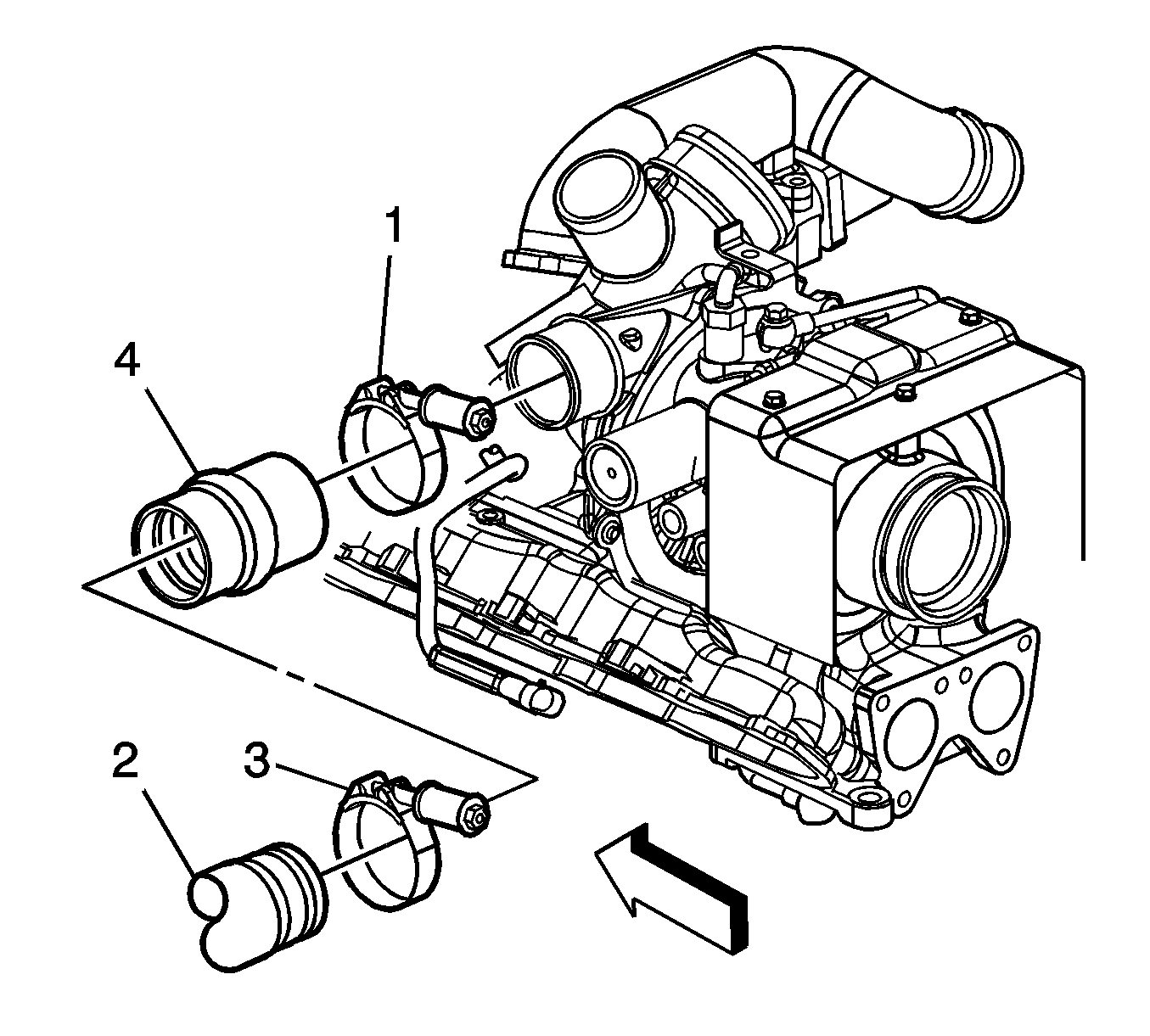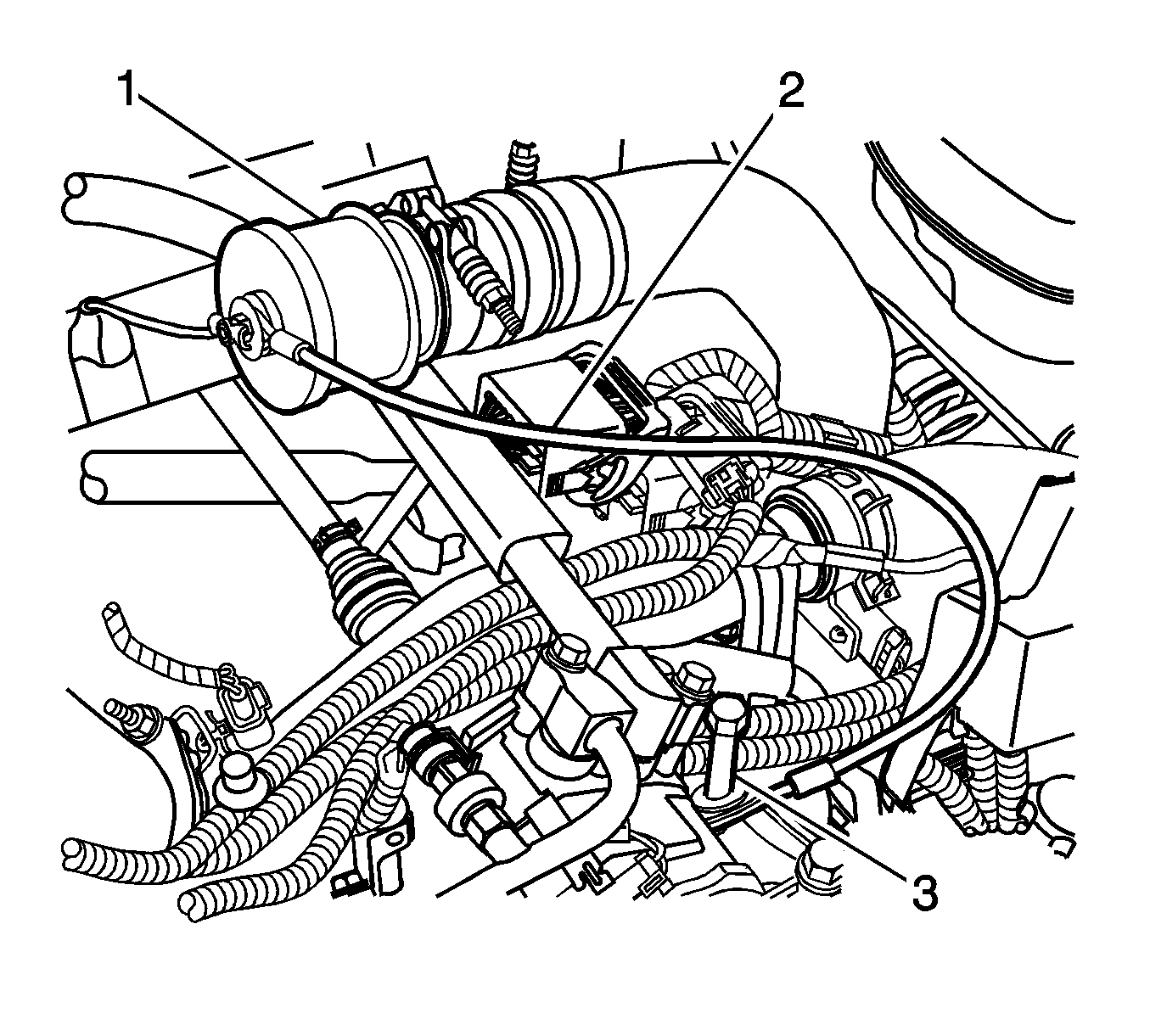Charge Air Cooler Diagnosis Charge Air Cooler Air Leak Test
Diagnostic Instructions
Special Tools
J 46091-1 Pressure Regulator Adjustment
Important: Some J 46091-1 regulators may have the adjusting knob riveted in place. The rivet head must be drilled out with a 5/16 inch drill bit before adjustment. Do not drill more than 1/8 inch in depth,
or just enough to remove the rivet head. The rivet shaft does not have to be removed from the regulator.
- Connect the
EN-47603
compression adapter to the
J 46091
gage set and connect shop air to the
J 46091
.
- Open the shutoff valve, then slowly turn the regulator on the
J 46091
clockwise until the gage reads 206 kPa (30 psi).
- Close the air supply valve and remove the
EN-47603
from the gage assembly.
- The gage set is now calibrated to perform the test.
Charge Air Cooler Outlet Connection (Engine Air Intake COLD Side)
Important: It is not necessary to remove the charge air cooler from the vehicle to perform this test.

- Loosen the charge air cooler (CAC) clamp (1) that fastens the right air cooler duct to the intake air heater (2).
Important: After removing the charge air cooler duct, cover the intake heater opening with tape in order to prevent entry of objects.
- Remove the right charge air cooler duct (3) from the intake air heater inlet.
- Install the J 46091-10 pressure adapter to the charge air duct.
- Use the clamp to secure the adapter to the charge air duct.
Tighten
Tighten the clamp to 8 N·m (70 lb in).
Caution: To prevent possible injury from the coupler blowing off the charge air cooler hose during the test, connect the safety cable before applying air pressure.
- Secure the safety cable.
Charge Air Cooler Inlet Connection (Engine Air Intake HOT Side)

- Remove the engine cover. Refer to
Engine Cover Replacement
.
- Loosen the right clamp that fastens the left air cooler duct to turbocharger (1).
Important:
| • | After removing the charged air cooler duct, cover the turbocharger opening with tape in order to prevent entry of objects. |
| • | Do not use a screwdriver or other tool to pry the hose loose. The hose can be torn or damaged. Loosen the hose by twisting. |
- Remove the left charge air cooler inlet duct connector (4) from the turbocharger.
- Use the clamp to attach the gage couple from the
J 46091
to the charge air hose.
Tighten
Torque the clamp to 8 N·m (70 lb in).
- Secure the safety cable.
Caution: Refer to Charge Air Cooler Caution in the Preface section.
- Attach the gage/regulator assembly from the
J 46091
to the quick disconnect fitting on the gage coupler.
Leak Test - Air Pressure Application
Caution: Refer to Charge Air Cooler Caution in the Preface section.
Important: Charge air coolers are not required to be leak proof. DO NOT test the cooler for leakage by submerging it in a radiator test tank. Almost all charge air cooler units will show leakage if they are submerged.
- Connect the filtered air supply to the air valve on the gage/regulator assembly.
- Open the air valve SLOWLY, increasing the air pressure in 34-69 kPa (5-10 psi) increments while listening for air leaks. Continue increasing the air pressure until the gage reads 205 kPa (30 psi).
- Close the air valve and monitor the gage for 15 seconds. Note any decrease in air pressure.
- Repeat the test 3 times to verify the results.
Leak Test Fails
If the pressure drop is more than 34 kPa (5 psi) in 15 seconds, the leak test has failed. Perform the following procedure:
- Inspect for air leaks using a pump spray bottle to apply a soapy solution to the pipes/hoses, charge air cooler hose connections, and charge air cooler core. Observe for bubbles.
- Replace or tighten the affected component as necessary.
- Retest the CAC system. If no other leaks are found, assemble the vehicle and clear the DTC information with a scan tool.
Leak Test Passes
If the pressure drop is less than 34 kPa (5 psi) in 15 seconds, the leak test passes. Remove the tester by performing the following procedure:
- Slowly bleed the air from the cooler by depressing the relief valve on the adapter plate.
- Remove the air hose, gage/regulator assembly, and both adapters.
- Connect the charge air hose to the turbocharger.
Tighten
Torque the clamp to 8 N·m (70 lb in).
Charge Air Cooler Diagnosis Full System Air Leak Test
Diagnostic Instructions
Reference Information
Special Tools
J 46091-1 Pressure Regulator Adjustment
Important: Some J 46091-1 regulators may have the adjusting knob riveted in place. The rivet head must be drilled out with a 5/16 inch drill bit before adjustment. Do not drill more than 1/8 inch in depth,
or just enough to remove the rivet head. The rivet shaft does not have to be removed from the regulator.
- Connect the
EN-47603
compression adapter to the
J 46091
gage set and connect shop air to the
J 46091
.
- Open the shutoff valve, then slowly turn the regulator on the
J 46091
clockwise until the gage reads 206 kPa (30 psi).
- Close the air supply valve and remove the
EN-47603
from the gage assembly.
- The gage set is now calibrated to perform the test.
Charge Air Cooler Inlet Connection (Engine Air Intake Hot Side)

Caution: Refer to Charge Air Cooler Caution in the Preface section.
Important: After removing the intake manifold cover, protect the engine opening to prevent entry of objects.
- Loosen the clamp (1) that fastens the left air cooler duct (4) to the turbocharger.
Important:
| • | After removing the charge air cooler duct, protect the turbocharger opening to prevent entry of objects. |
| • | Do not use a screwdriver or other tool to pry the hose loose. The hose can be torn or damaged. Loosen the hose by twisting. |
- Remove the left charge air cooler inlet duct connector (4) from the turbocharger.
- Remove the engine cover. Refer to
Engine Cover Replacement
.
- Remove the air cleaner assembly. Refer to
Air Cleaner Assembly Replacement
.
Notice: Refer to Fastener Notice in the Preface section.

- Use the clamp to attach the J-46091-2 (1) from the
J 46091
to the duct connector.
Tighten
Tighten the clamp to 8 N·m (70 lb in).
- Secure the
J 46091
(1) safety cable (2) to a safe location (3).
Turbocharger Exhaust Pipe Connection
Caution: Refer to Charge Air Cooler Caution in the Preface section.
- Raise and support the vehicle. Refer to
Lifting and Jacking the Vehicle
.
- Remove the catalytic converter. Refer to
Catalytic Converter Replacement
.
Important:
| • | An improperly seated J-46091-15 adapter will cause an excessive air leak and hissing noise. |
| • | An early version of the J-46091-15 adapter has a quick-connect air fitting installed in the center of the adaptor. Remove the quick-connect air fitting and install a 1/8 pipe plug. |
- Install the J-46091-15 Adapter with the exhaust pipe clamp to the turbocharger exhaust pipe using the clamp from the catalytic converter.
Air Pressure Application
Caution: Refer to Charge Air Cooler Caution in the Preface section.
- Attach the gage/regulator assembly from the
J 46091
to the quick disconnect fitting on the J-46091-2.
- Connect the air supply to the air valve on the gage/regulator assembly.
- Open the air supply valve slowly, increasing the air pressure to a maximum of 206 kPa (30 psi) while listening for abnormal air leaks.
Important:
| • | An air leak hissing sound at the EGR valve vent port is normal. |
| • | For accurate readings you must allow approximately 30 seconds for the air pressure to stabilize. |
| • | The engine will not hold pressure if the gage valve is turned OFF. |
| • | If an excessive air leak hissing sound at turbocharger outlet is present, rotate the crankshaft 90 degrees. |
- Leave the valve ON for the duration of the test.
Leak Test Results
Important:
| • | An air leak that appears as small bubbles or foaming is normal. |
| • | Intake Air Heater gaskets that show a small leak or foaming is normal. |
- With the air valve ON, the gage on the regulator assembly should read greater than 158 kPa (23 psi), and there should be no abnormal air leaks.
| ⇒ | If the air pressure gage reads less than 158 kPa (23 psi) with constant air pressure applied, and audible air leaks are present, the leak test has failed. Perform the following procedure: |
| 1.1. | Inspect for air leaks by listening for excessive hissing sounds. |
| 1.2. | Inspect for air leaks by using a pump spray bottle to apply a soapy solution, while observing for excessive soapy bubbles at all of the following engine locations: |
| • | Charge air cooler pipes/hoses connections |
| • | EGR valve cooler gaskets |
| • | Exhaust manifold gaskets |
| • | Turbocharger gaskets, inlet and outlet connections |
| • | Intake manifold gaskets |
| ⇒ | If any abnormal leaks are found, replace the affected gasket or component as necessary. |
- Retest the engine system for air leaks. The gage on the regulator assembly should read greater than 158 kPa (23 psi), and there should be no abnormal air leaks.
| ⇒ | If the gage reads less than 158 kPa (23 psi) with air valve ON, and audible air leaks are present, recheck for air leaks. |
- If no other air leaks are found, assemble the vehicle. Remove the tester and adapters by performing the following procedure:
| 3.1. | Slowly bleed the air from the cooler by depressing the relief valve on the adapter. |
| 3.2. | Remove the air hose, gage/regulator assembly, and both adapters. |
| 3.3. | Connect the charge air hose to the turbocharger with the clamp. |
Tighten
Tighten the clamp to 8 N·m (70 lb in).
| 3.5. | Clear all DTC information with a scan tool. |
Charge Air Cooler Diagnosis Induction System Smoke Test
Diagnostic Instructions
Circuit/System Description
The purpose of the Intake Air Leak Smoke Test is to aid in finding an air leak between the mass air flow sensor and turbocharger inlet. This test will also aid in finding air leaks in the crankcase ventilation system.
Reference Information
Special Tools
| • | J 41413-200
Evaporative Emission System Tester (EEST) |
Smoke Test Application
Important:
| • | To operate the EVAP tester, refer to
J 41413-200
operation manual. |
| • | Smoke at the EGR valve vent port is normal. |
- Ignition OFF, remove the air filter restriction indicator.
- Connect the
J 41413-200
to the vehicle at the air restrictor indicator port.
- Place the air filter in a disposable plastic bag in the air cleaner housing to help prevent smoke leakage.
- Remove the engine cover. Refer to
Engine Cover Replacement
.
- Apply smoke continuously with the
J 41413-200
while moving all duct work, pipes, and tubes.
- To improve the visibility of the smoke exiting the engine, observe the suspected leak area from different angles.
- Inspect for smoke at the following locations:
| • | Crankcase ventilation hoses and pipes |
| • | Mass air flow intake air ducts |
| • | Turbocharger inlet and outlet connections |
| ⇒ | Replace the affected gasket, seal, or component as necessary. |
- Retest the engine for air leaks.
- Remove the disposable bag from the air filter. Install the air filter and air filter restriction indicator.
- Install the engine cover. Refer to
Engine Cover Replacement
.




